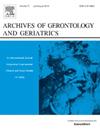Association between pro-inflammatory dietary patterns and chronic pain in community-dwelling older adults: A cross-sectional study
IF 3.8
3区 医学
Q2 GERIATRICS & GERONTOLOGY
引用次数: 0
Abstract
Background
Persistent inflammation is a key factor in the development of chronic pain, as diet can modulate inflammation, it may influence the risk of chronic pain risk. Pro-inflammatory dietary patterns—characterized by higher Dietary Inflammatory Index (DII) scores, indicating dietary patterns that promote systemic inflammation—may be particularly relevant. The impact of diet on inflammation and pain may vary by individual factors such as sex, age, and psychological status. This study examined this association with a particular focus on sex differences.
Methods
This cross-sectional study used baseline data from the Itabashi Longitudinal Study on Aging, a cohort of community-dwelling older adults in Tokyo. The DII was derived from dietary data collected via a self-administered diet survey. Binary logistic regression analysis was performed with sex and DII quartile interaction terms as exposure variables and chronic pain (pain lasting ≥three months) as outcome, adjusted for age, overweight, educational level, and smoking status.
Results
Using men in the lowest DII quartile as the reference group, women had significantly higher odds ratios (OR) for chronic pain across all DII quartiles (first, OR: 1.69, 95% CI: 1.16–2.46; second, OR: 1.84, 95% CI: 1.27–2.67; third, OR: 1.64, 95% CI: 1.12–2.40; and fourth, OR: 2.51, 95% CI: 1.73–3.66).
Conclusions
Our findings suggest that the association between a pro-inflammatory diet, as reflected by higher DII scores, and chronic pain may differ by sex and that systemic inflammation may be involved. These findings underscore the need for sex-specific dietary strategies to manage chronic pain.
在社区居住的老年人中,促炎饮食模式与慢性疼痛之间的关系:一项横断面研究。
背景:持续性炎症是慢性疼痛发生发展的关键因素,饮食可以调节炎症,从而影响慢性疼痛的发生风险。促炎饮食模式——以较高的饮食炎症指数(DII)为特征,表明饮食模式促进全身性炎症——可能特别相关。饮食对炎症和疼痛的影响可能因个人因素而异,如性别、年龄和心理状态。这项研究以性别差异为重点考察了这种联系。方法:这项横断面研究使用的基线数据来自Itabashi纵向老龄化研究,这是一项东京社区老年人队列研究。DII来自通过自我管理的饮食调查收集的饮食数据。以性别和DII四分位数相互作用项作为暴露变量,慢性疼痛(疼痛持续≥3个月)作为结果,并根据年龄、超重、教育水平和吸烟状况进行调整,进行二元logistic回归分析。结果:以最低DII四分位数的男性作为参照组,女性在所有DII四分位数中慢性疼痛的优势比(OR)明显更高(第一,OR: 1.69, 95% CI: 1.16-2.46;第二,OR: 1.84, 95% CI: 1.27-2.67;第三,OR: 1.64, 95% CI: 1.12-2.40;第四,OR: 2.51, 95% CI: 1.73-3.66)。结论:我们的研究结果表明,高DII评分所反映的促炎饮食与慢性疼痛之间的关系可能因性别而异,并且可能涉及全身性炎症。这些发现强调了针对不同性别的饮食策略来控制慢性疼痛的必要性。
本文章由计算机程序翻译,如有差异,请以英文原文为准。
求助全文
约1分钟内获得全文
求助全文
来源期刊
CiteScore
7.30
自引率
5.00%
发文量
198
审稿时长
16 days
期刊介绍:
Archives of Gerontology and Geriatrics provides a medium for the publication of papers from the fields of experimental gerontology and clinical and social geriatrics. The principal aim of the journal is to facilitate the exchange of information between specialists in these three fields of gerontological research. Experimental papers dealing with the basic mechanisms of aging at molecular, cellular, tissue or organ levels will be published.
Clinical papers will be accepted if they provide sufficiently new information or are of fundamental importance for the knowledge of human aging. Purely descriptive clinical papers will be accepted only if the results permit further interpretation. Papers dealing with anti-aging pharmacological preparations in humans are welcome. Papers on the social aspects of geriatrics will be accepted if they are of general interest regarding the epidemiology of aging and the efficiency and working methods of the social organizations for the health care of the elderly.

 求助内容:
求助内容: 应助结果提醒方式:
应助结果提醒方式:


